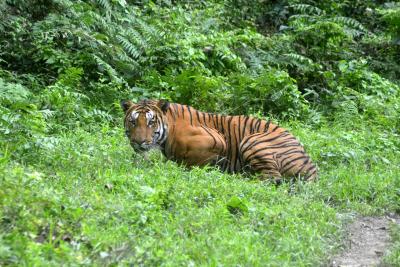By Tanuj DharGuwahati, April 8 : Prior to the publication of the census results on Sunday, the two major Assam tiger reserves — Kaziranga and Manas — are anticipated to experience a spike in the tiger population after previously experiencing several difficulties.
The major issue with Kaziranga was expansion, as the authorities of the National Park could not take over a lot of land until 2020.
Speaking to IANS, Shiv Kumar, the Chief Conservator of Forests and former Director of Kaziranga National Park and Tiger Reserve (KNPTR), said: “Before 2015, Kaziranga had a lot of issues with the possession of land.A major portion of the park was encroached upon, and it had an adverse effect on the tiger population.”
Though the total area of the KNPTR is about 1,300 square kilometres, earlier the authority had possession of only 400 square kilometres.
“We had control only over the core area.But, over the last few years, we could get back a lot of land.In 2020, we recovered a major portion,” Kumar said.
Kaziranga now has 10 ranges, compared to its earlier four.At present, it has three divisions.
“With this remarkable increase, we could bring a lot of change to the animal habitat that included watershed management and others,” Kumar added.
KNPTR has a metapopulation of animals.
It has a good number of one-horned rhinos, along with tigers.Following the acquisition of most of the encroached land, a major expansion of Kaziranga has occurred in the last couple of years.
“Assam’s two other tiger reserves, Nameri and Orang, are situated on two sides of Kaziranga.We have built connectivity with both of these tiger reserves.
This has eased the movement of tigers among Kaziranga, Nameri, and Orang.Nowadays the animals have a largely expanded habitat,” the forest officer added.
Monsoon floods are major issues in Kaziranga, where animals almost always face a lot of trouble during the summer.A large portion of the park gets submerged under the floodwaters, with animals left with shrunken spaces.This has caused innumerable deaths of animals, too.
“Karbi Anglong forests are on another side of Kaziranga, which has hills.We have planned to build nine animal corridors that connect Kaziranga with the Karbi Anglong forests.This has facilitated the movements of animals during the floods,” Kumar further informed.
In the 2018 census, there were 104 tigers in Kaziranga.With a lot of measures put in place, the forest department is extremely hopeful that the numbers will show a surge this time.
When Project Tiger was initiated 50 years ago by the Central government, Assam’s Manas National Park was one of the nine tiger reserves selected for this ambitious project.
However, the long Bodo agitation had an opposing impact on the state’s second-largest tiger reserve.
Vaibhabh Mathur, the director of Manas National Park and Tiger Reserve, said: “The National Tiger Conservation Authority (NTCA) was set up by the government, which came up with a set of guidelines on how to run a tiger reserve on a day-to-day basis.All these were also codified into the Wildlife Protection Act.”
But, during the Bodo agitation, Manas was under severe threat, and rhinos were completely wiped out from the park.
“Once, the Manas National Park had a very healthy population of tigers.At their peak, there were at least 70 to 80 adult tigers.But after Bodo agitation began, the tigers being a very sensitive animal, the population almost completely moved out of Manas,” said Mathur.
Along with the unrest, a lot of other things were also happening in Manas that actually violated the Standard Operation Procedures (SOP) laid down by the NTCA to run tiger reserves in the country.
“Night stays were happening in the core area, making noises within the forest, plying of the numerous private cars, vehicles from Bhutan were using Manas as a highway, etc.All of these forces have the tigers and other animals leaving Manas National Park,” Mathur said.
However, since the return of peace to the Bodoland region, the Manas National Park and Tiger Reserve has been slowly recovering its earlier position.
“Thanks to the signing of the Bodo peace accord, there is now a peaceful environment in the region.This has also helped us adhere to the codified guidelines prescribed by the NTCA,” Mathur commented, adding that other disturbances that were adversely impacting the tiger population also came to an end.
“From 10, the tigers’ number has shown a marvellous jump in the last couple of years.In 2022, we had 52 adults here which was a five-fold increase,” the forest officer said.
“With the latest census going public on Sunday, we have been expecting a further positive outcome for the tiger population in Manas National Park.”
tdr/
#Kaziranga #Bodo #Manas #Assam #tiger #surgE # Assam #Guwahati # Assam







